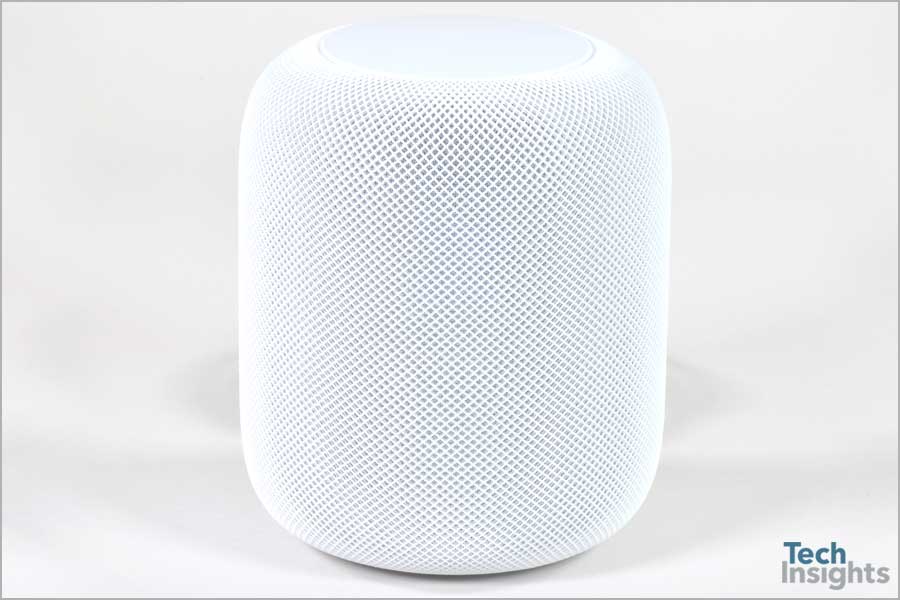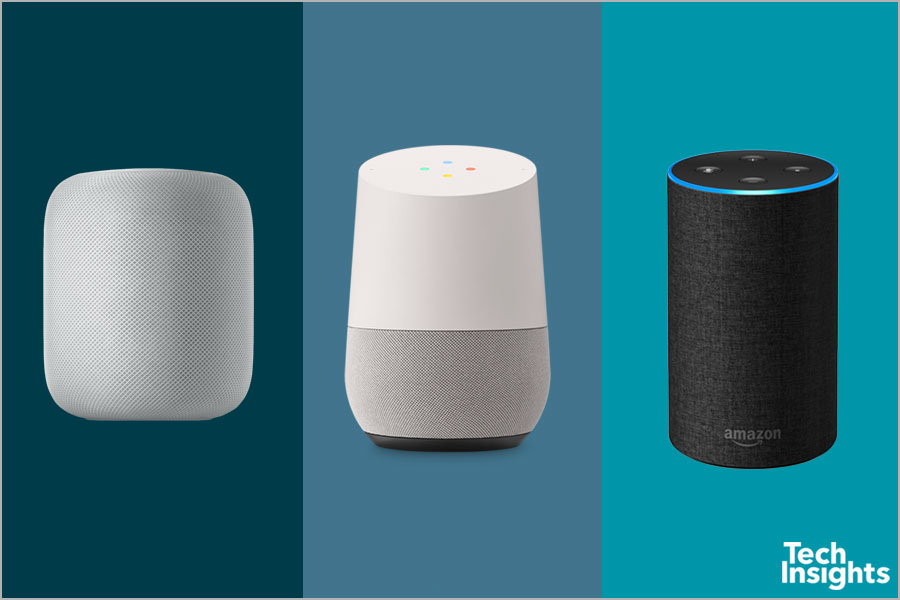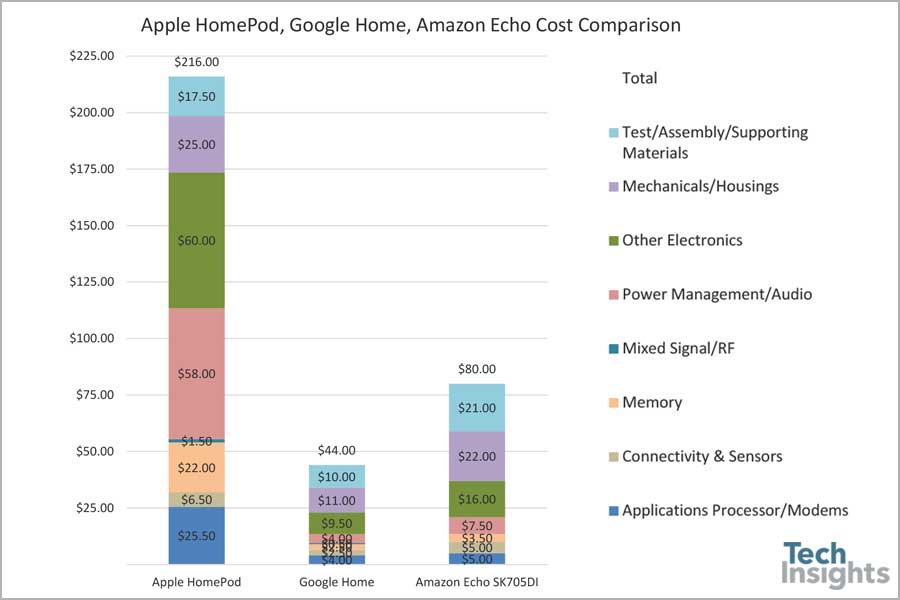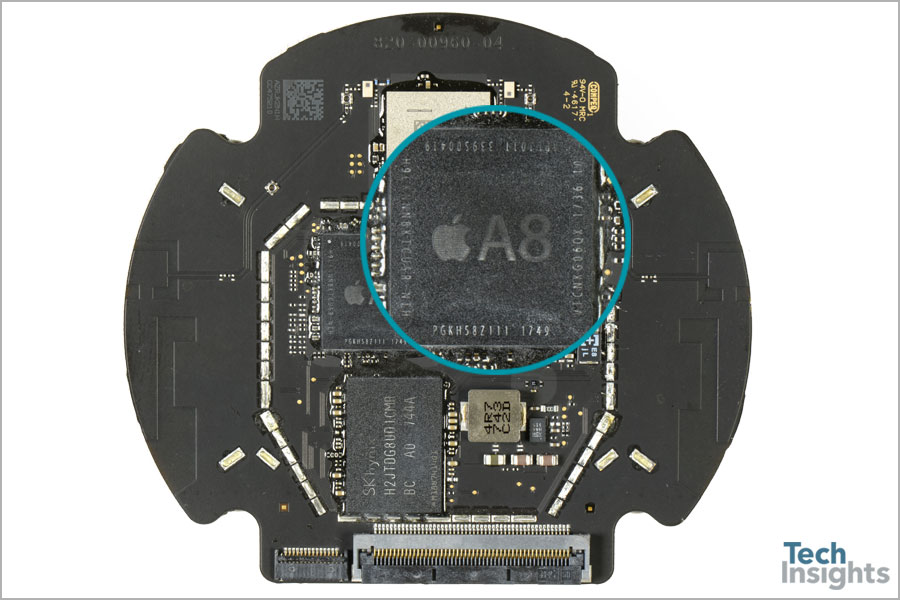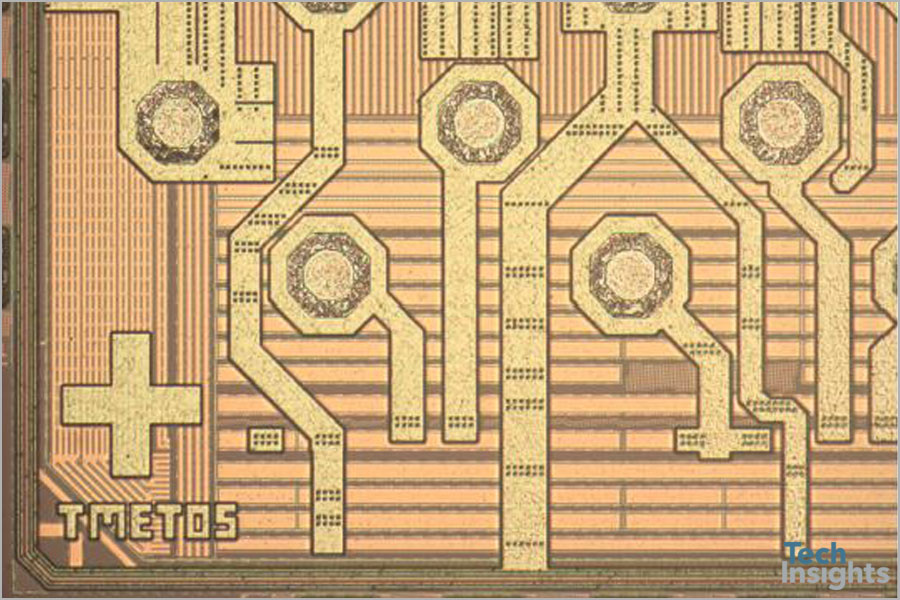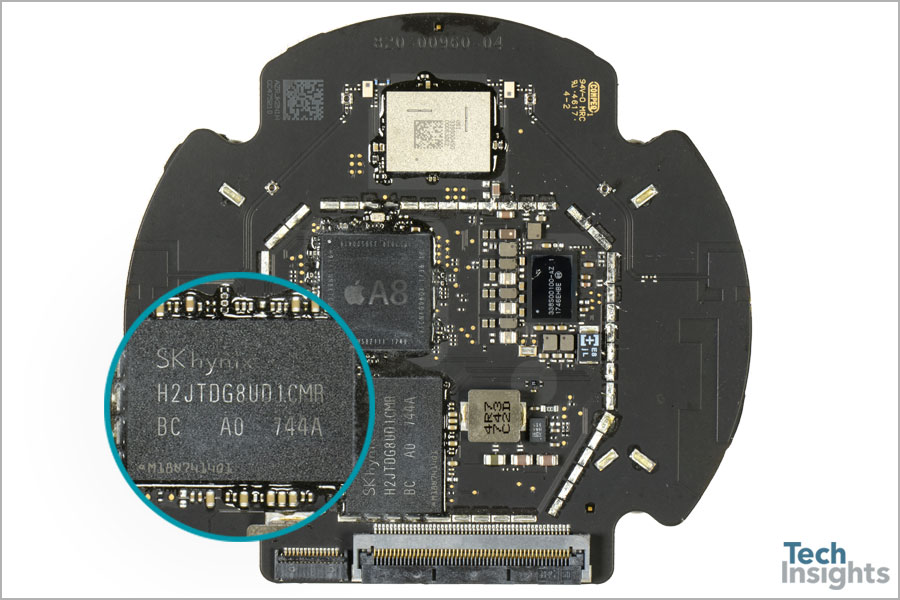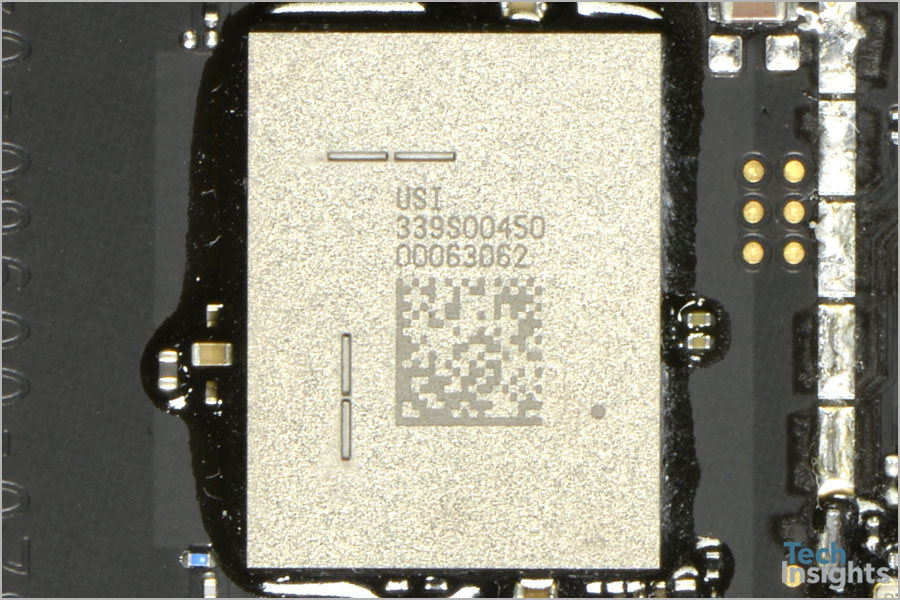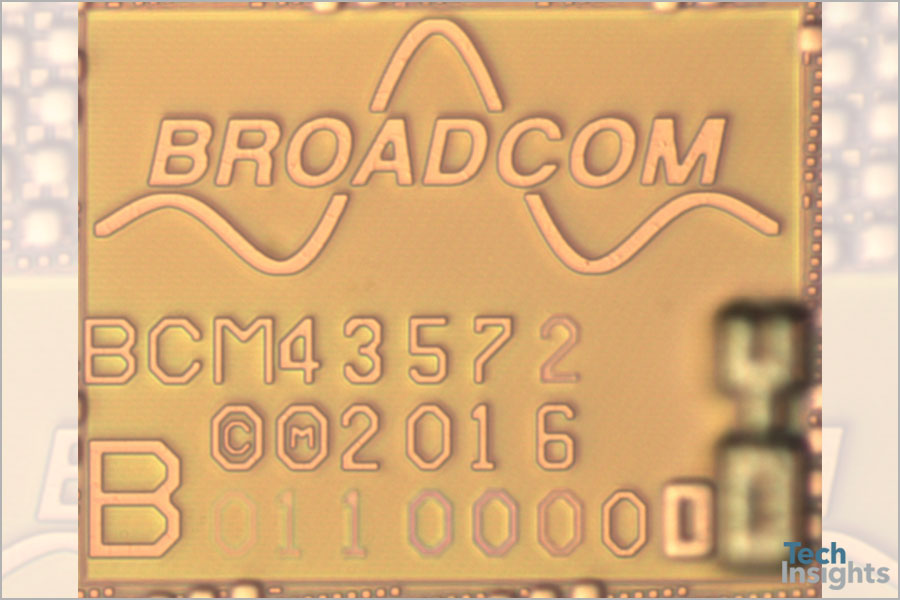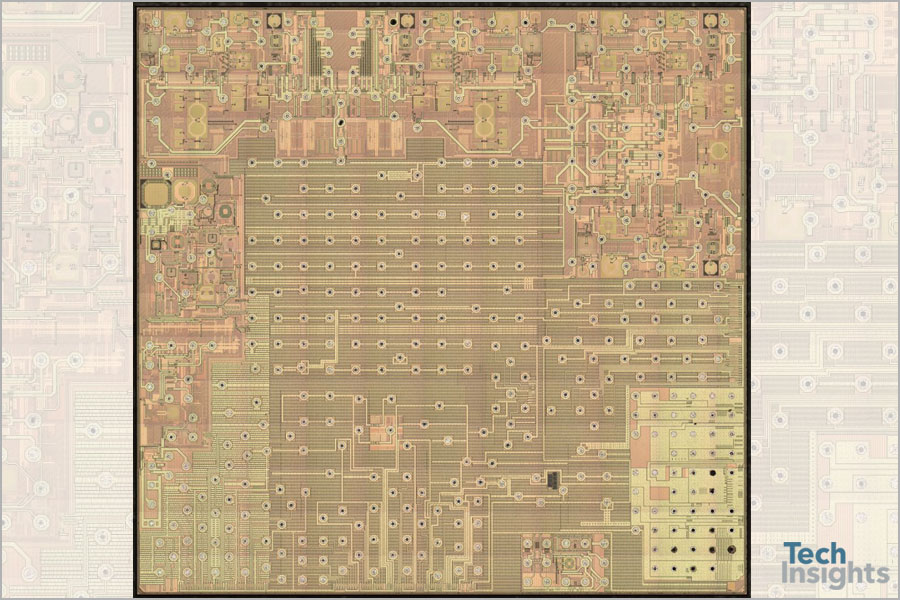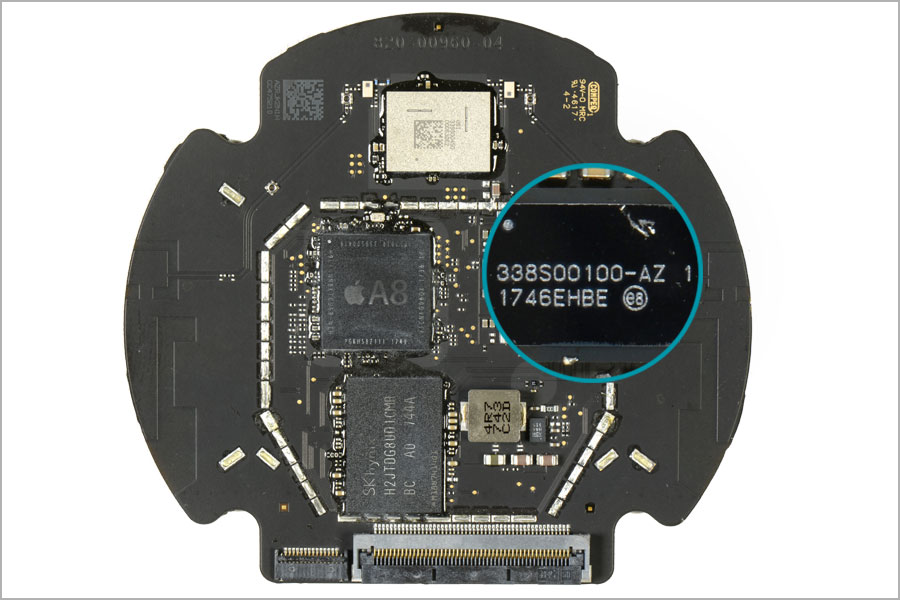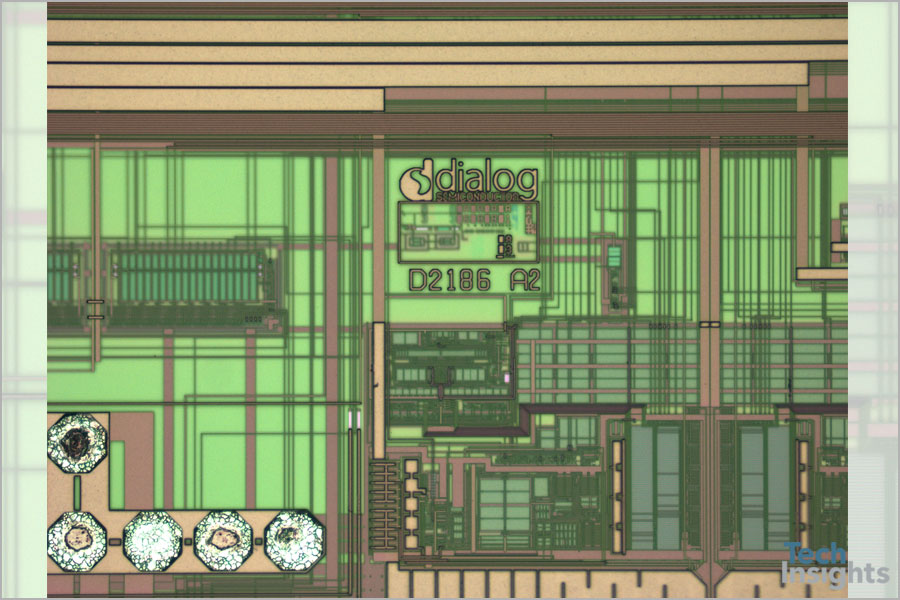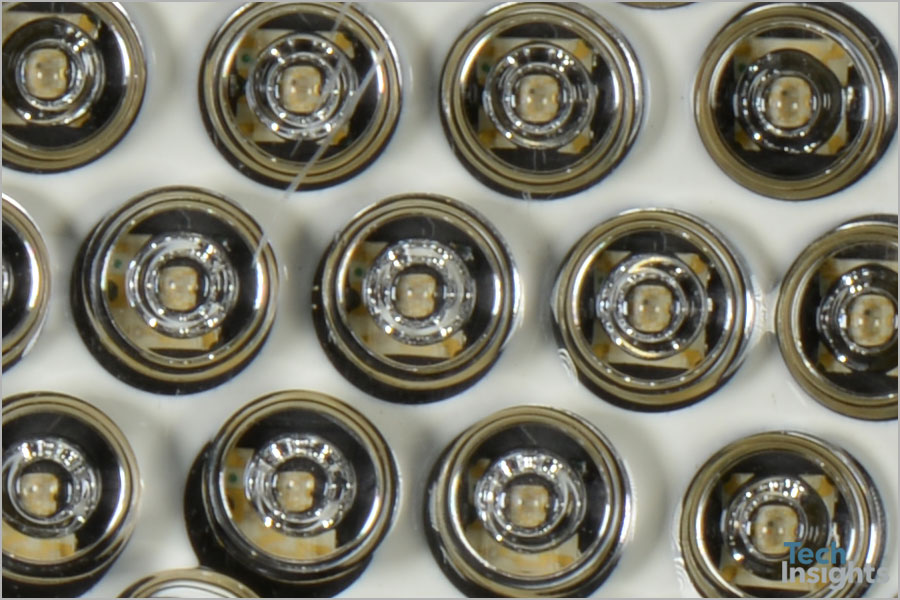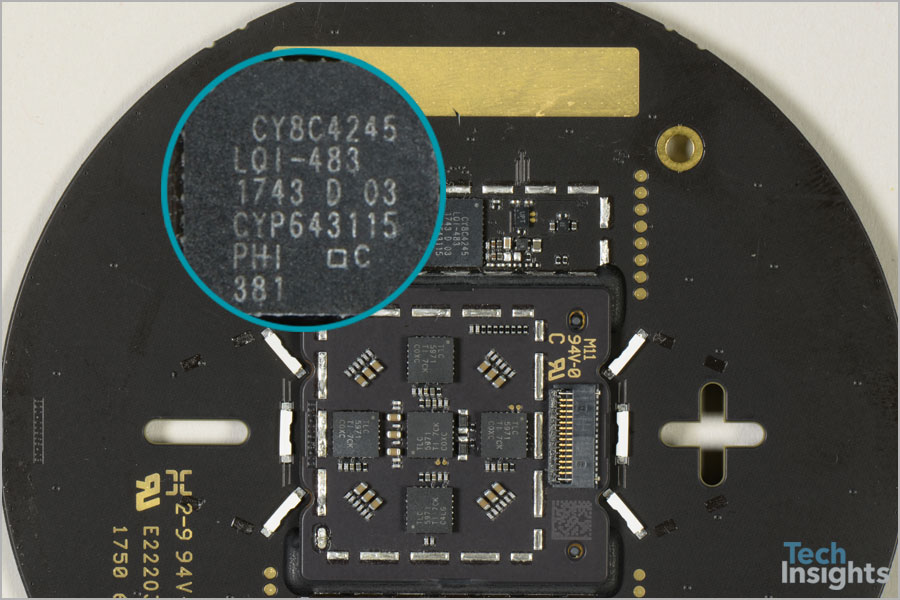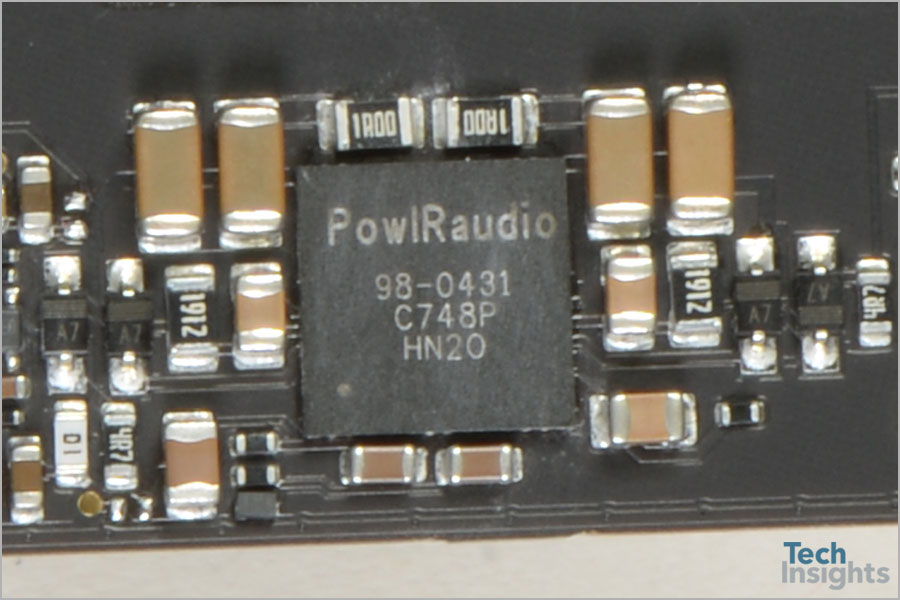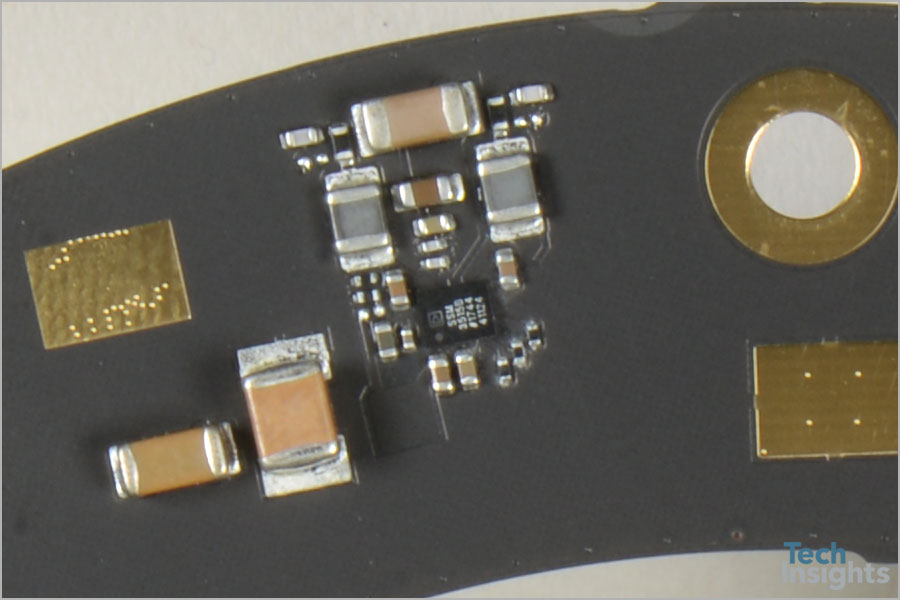February 16, 2018
Contributing Authors: Stacy Wegner, Daniel Yang, Kim Waterman
Cost Comparison Observations
Since the introduction of the Amazon Echo smart speaker back in 2015, OEMs like Google, Xiaomi, Lenovo and others have released their own versions into the growing smart home market. And, maybe after hearing the echoes of success from their competitors, Apple announced their own speaker assistant in 2017, the Apple HomePod.
Apple delayed the HomePod November release date and missed the 2017 holiday shopping season. That is okay with us as we had our hands full tearing down the iPhone X phones and learning all about dot projectors and facial unlock features.
The good news is we have a HomePod now, and our team has it apart and in pieces. Many, many pieces.
Finding Its Spot in the IoT Home
Undisputedly, it is Amazon leading the pack right now with smart assistants and speakers in the IoT smart home space. We have looked at a few of the products in the Echo line, from the Spot to the Dot (1st gen and 2nd gen)and the Echo Show, and this may be the first time we are using something other than an Apple device as the basis for comparison. Instead of comparing competing products to an Apple device, this time around we are comparing an Apple HomePod to an Amazon Echo and to a Google Home.
First, controlling the devices: the older Echo comes with a remote controller, the Google Home and Apple HomePod do not. All three are enabled and respond to voice commands with the help of their respective virtual smart assistants – Amazon’s Alexa, Google's Assistant and Apple's Siri are a big part of what make these smart speakers 'smart'.
The total number of speakers per device is where the Apple HomePod pulls away from the other two. The HomePod has not one, not two, but eight speakers total inside of it; the Google Home has one speaker and the trendsetting Amazon Echo has two.
To be fair, both the Amazon Echo and Google Home are a little older, but smart home and other IoT home products do not suffer the same blink-of-an-eye turnover rate as mobile phones or phablets. Mobile phones and phablets tend to include the latest in technology and features, but IoT smart home products (so far) can rely on mostly legacy components. This will keep up as long as smart home devices continue to meet the consumer's expectations - whether it be simple monitoring of the home environment or offering the functionality of virtual assistant software.
Costing and Comparing
There was a bit of an uproar over the margins on Apple’s iPhoneX – theirs was the highest margin of last year’s flagship phones. So is the story the same with the HomePod?
Short answer: no.
Although the Apple HomePod is by far the most expensive of the three we are comparing, it carries – by far – the lowest margin. By our calculations, the parts cost of the HomePod equates to $216, the warranty is $32.40, for a combined total of $248.40. With an average sale price of $349, the margin is 29%. In comparison, the margin on the Google Home is 61%, and the margin on the Amazon Echo is 49%.
To put the margins in perspective, however, one might also consider profit. With the margin of 29%, the Home Pod still brings Apple $100.60, where the Google Home brings in $78.40 per unit, and the Amazon Echo brings in $87.99 per unit.
For Apple to achieve margins around 50% - in the range of the Google and Amazon products - they would have had to sell the HomePod for roughly $500. A $500 price tag likely would have made a negative impact on sales, so Apple was faced with a dilemma: keep their margins high at the expense of sales, or reduce margins and keep their sales up. We suspect the $349 price point was a compromise designed to keep both margins and sales within satisfactory ranges.
Cost Comparison Detail: Apple HomePod, Google Home, Amazon Echo
| Apple HomePod | Google Home | Amazon Echo SK705DI | |
|---|---|---|---|
| Teardown Date | February 2018 | February 2017 | November 2015 |
| Applications Processor/Modems | $25.50 | $4.00 | $5.00 |
| Connectivity & Sensors | $6.50 | $2.50 | $5.00 |
| Memory | $22.00 | $2.50 | $3.50 |
| Mixed Signal/RF | $1.50 | $0.50 | |
| Power Management/Audio | $58.00 | $4.00 | $7.50 |
| Other Electronics | $60.00 | $9.50 | $16.00 |
| Mechanicals/Housings | $25.00 | $11.00 | $22.00 |
| Test/Assembly/Supporting Materials | $17.50 | $10.00 | $21.00 |
| Total | $216.00 | $44.00 | $80.00 |
| Warranty/Royalty/etc. | $32.40 | $6.60 | $12.00 |
| Total | $248.40 | $50.60 | $92.00 |
| Average Selling Price | $349.00 | $129.00 | $179.99 |
| Margin $ | $100.60 | $78.40 | $87.99 |
| Margin % | 29% | 61% | 49% |
* Costing note: All cost estimates provided here are compiled using information available to us at the time of the initial teardown. Some assumptions have been made where concrete data is not yet available. We will continue to gather and refine this costing data throughout our on-going deep-dive teardown process and analysis. While we do not expect drastic cost changes, we do expect some adjustments.
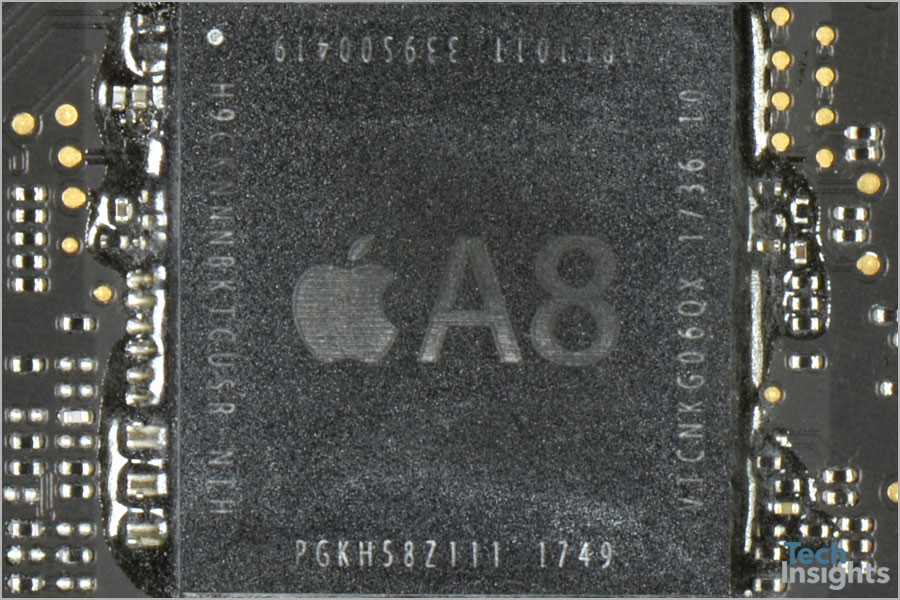
A8 Application Processor
Application Processor
According to Apple themselves, the HomePod is designed on their own A8 processor, which was introduced in the Apple iPhone 6 and iPhone 6 Plus phones back in 2014.
The A8 is a Package on Package (PoP) IC component. In our HomePod, the A8 has an SK Hynix H9CKNNNBKTCUSR mobile SDRAM assembled on top of it, thus completing the Package-on-Package assembly. Going even deeper down to the die level, the A8 processor is fabbed by TSMC on their 20nm HKMG CMOS die technology. TechInsights offers the Basic Functional Analysis FAR-1409-801 and DSA 0715-39908-O-5DL-103 reports for more details.
The Apple A8 is newer and has the largest die area when compared to the older 2010 design of the TI DM3725CUS100 DSP found in the Amazon Echo and the 2012 design of the Marvell 88DE3006 DSP inside the Google home.
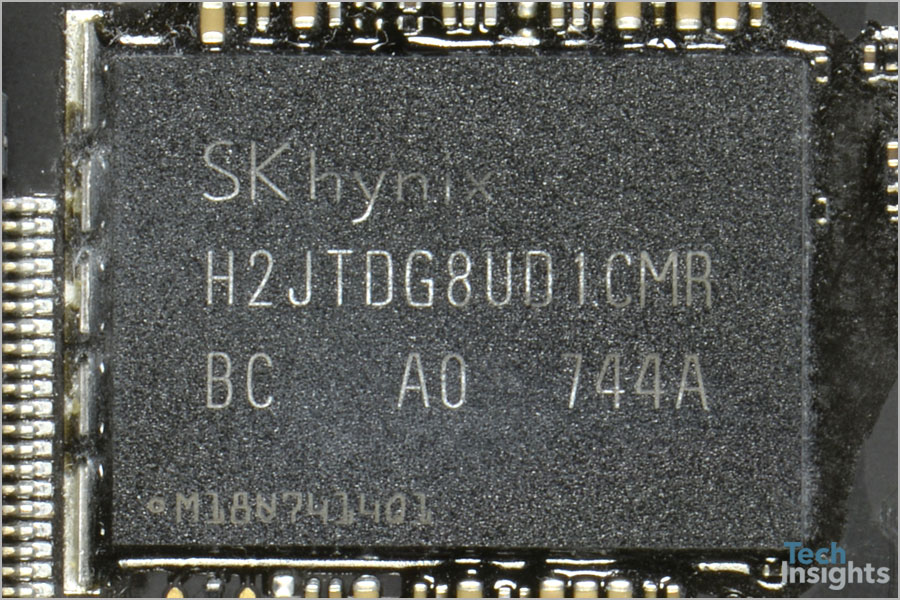
SK hynix H2JTDG8UD1CMR on the Apple HomePod Board
Flash Memory
We have seen reports of other HomePods using a Toshiba THGBX4G7D2LLDYC 16 GB NAND flash, but our HomePod came with a H2JTDG8UD1CMR, a 128Gb E2NAND3.0 NAND Flash memory chip from SK Hynix.
For those a little rusty on how many bits are in a byte, a 128 Gb (gigabit) equals 16 GB (gigabyte). What this means is the 16 GB NAND in the HomePod is larger than the 4 GB NAND in the Amazon Echo, and much larger than the 256 MB of SLC NAND in the Google Home speaker. To compare the HomePod memory size with a more recent Echo, the Amazon Echo Show only had 8 GB memory, still smaller than the 16 GB in the HomePod.
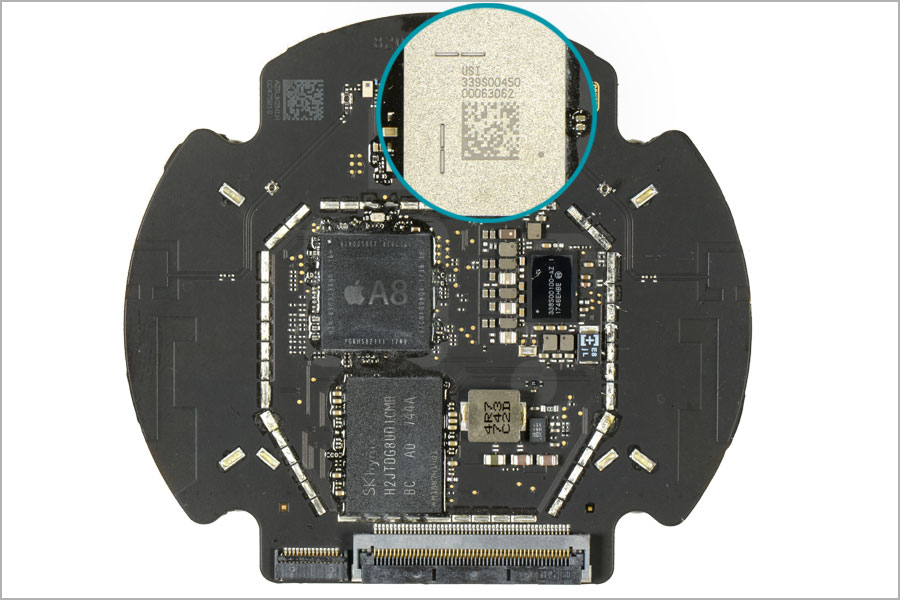
WiFi / Bluetooth 5 USI 339S00450 module
Wireless Combo Module
We were very interested to see if we would find Broadcom inside the HomePod's WiFi / Bluetooth 5 USI 339S00450 module. Officially Broadcom sold their IoT business to Cypress Semiconductor, only keeping the mobile and wireless router products, but...the HomePod is neither a mobile device nor a router. We even heard rumors MediaTek won the socket with their own new WiFi / Bluetooth 5 SoC.
But we do not deal with rumors, we deal with evidence, and we found the same Broadcom die inside our USI module as what was in the iPhone 8, iPhone 8 Plus, and iPhone X phones.
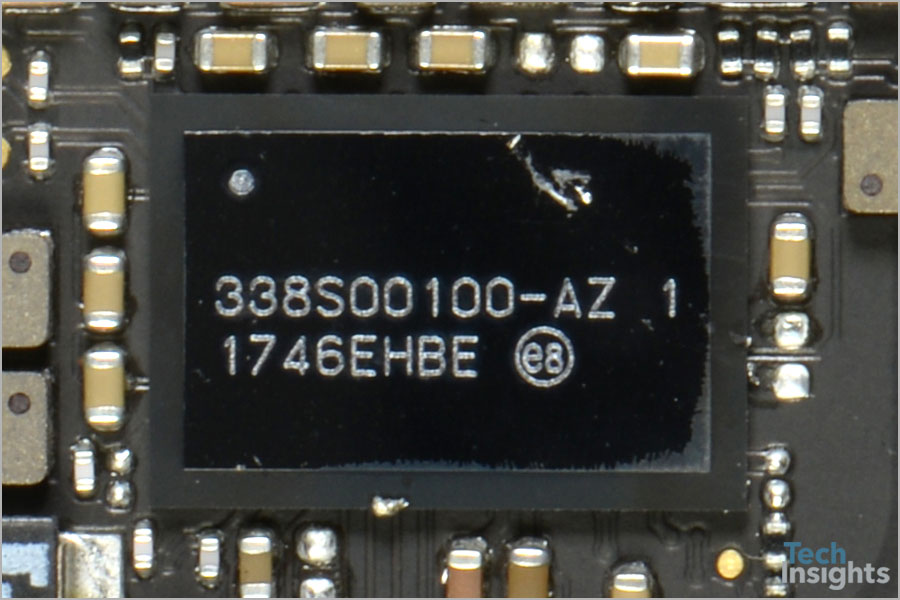
Apple/Dialog 338S00100 PMIC on the Apple HomePod Board
PMIC
News hit last December that Dialog Semiconductors may lose its place in Apple products to an Apple-designed PMIC. When we first looked at the new HomePod power management IC, we noted its similarities to the Apple/Dialog PMIC 338S1251 used in the iPhone 6 and iPhone 6 Plus. Our lab col-sm-12 col-lgleagues quickly depotted and confirmed this new 338S00100 PMIC has a same die as the 338S1251 in the iPhone 6 phones. This means Dialog Semi is still a winner for now in the HomePod.
Power management and control are nothing to take for granted, especially for a product with so many speakers. Here, Texas Instruments has also won with a few TPS62130 and TPS54560 DC/DC converter components.
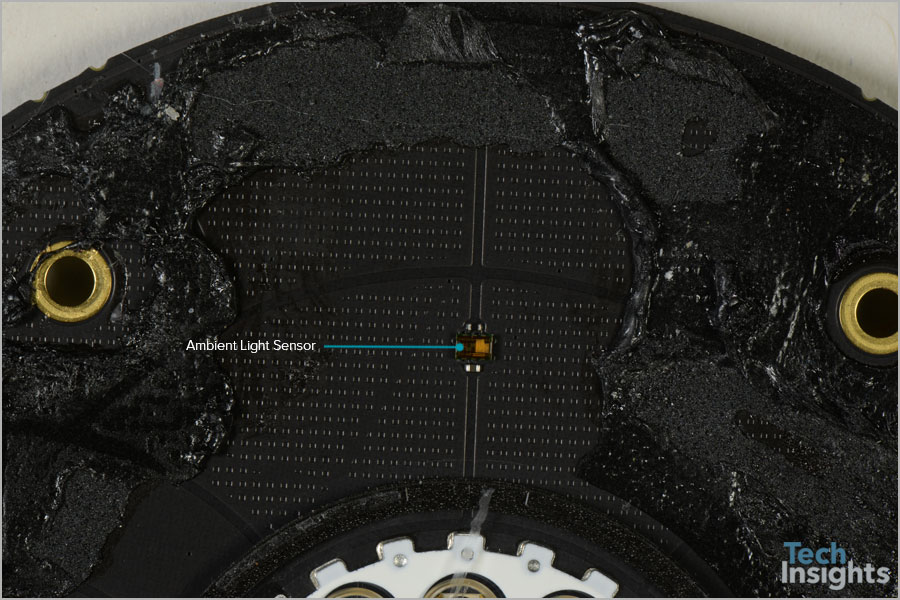
Cypress CY8C4245LQI-483 PSoC 4200
Touch Control
The HomePod does have gesture and touch sensing on the top of the speaker in the same way the Google Home and many new smart speakers have. The touch sensor and controller is a Cypress PSoC 4 CY8C4245LQI-483 with an ARM® Cortex-M0 CPU.
A quick side bar – we also found an ambient light sensor, no word on who supplied it yet. It is assembled on the cap-sense side of the PCB. At this point, we believe the capacitive sensing is part of the 8-layer PCB and not a separate assembly piece.
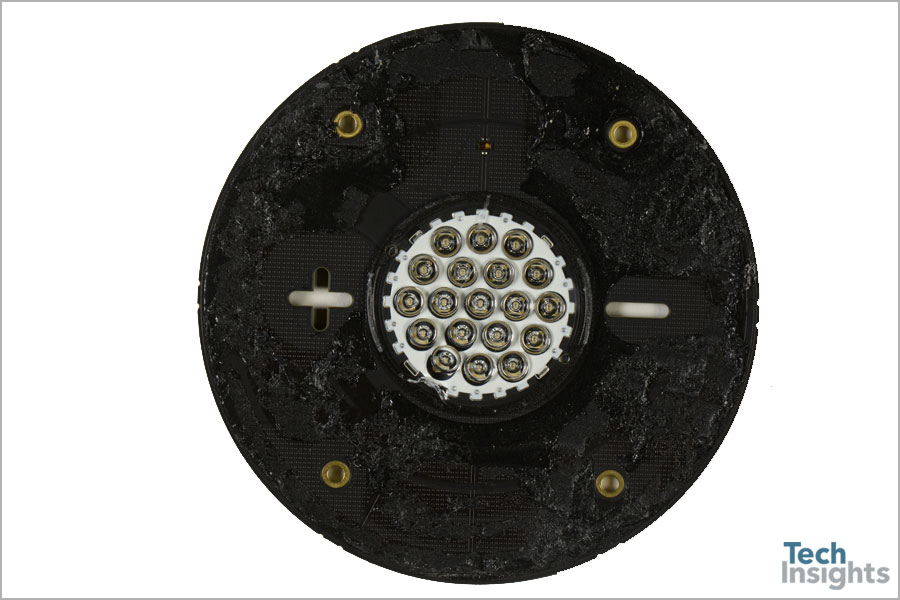
Microcontroller
MCU (Microcontroller)
STMicroelectronics wins the MCU socket. STM32L051C8, a 32MHz ARM Cortex-M0 MCU.
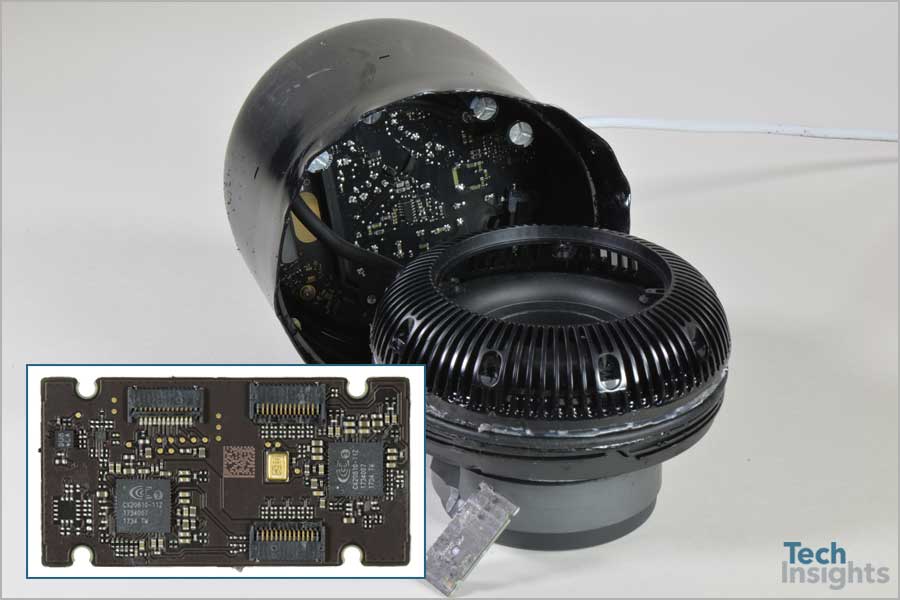
Audio ICs and Microphones Board
Audio ICs and Microphones
We mentioned the speakers, but we have not talked about what is driving the speakers nor who is listening and processing the voice commands.
For the speakers, we have identified what we believe is an International Rectifier (now Infineon) PowIRaudio IR43xx Class-D Amplifier, and seven Analog Devices SSM3515B Class-D Audio amplifiers. We assume each of the seven tweeters get their own Analog Device amplifier.
For voice commands to work, smart devices need microphones to listen for commands. Like most microphones, MEMS microphones have limits to their sensitivity and directionality for picking up sounds which is why a few of these voice-enabled assistants are designed with multiple microphones. Our HomePod has seven Knowles microphones. Finding Knowles as the only supplier in all seven MEMS microphones spots is something different than what we have found in the Apple iPhone mobile devices, where the microphones were supplied by Knowles, STMicro, AAC, and Goertek.
Taking the analog sounds waves of voice and converting to digital for the HomePod is a Conexant (now Synaptics) CX20810 ADC Voice Capture IC.
Bringing It All Home
HomePods, and other smart speakers and IoT Smart Home products, will rely heavily on their virtual assistants, and on incorporating new technologies like WiFi 802.11ac with its 8x8 MIMO support, and Bluetooth 5 mesh networking and low power features and capabilities.
From an IC standpoint, we did not find anything 'new' in the HomePod; we have seen most , if not all, of these components in other Apples and in products by other providers. Apple does well at design recycling, and their use of older ICs helps keep manufacturing costs low. It also means they do not have to try to reinvent the speaker, so instead their focus is on making their speaker better than those of the competition.





